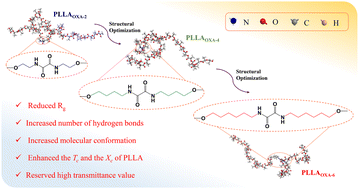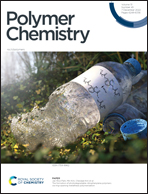Tailoring the crystallization of poly(l-lactide) via structural optimization of hydrogen-bonding segments with different aliphatic spacer lengths†
Abstract
In this work, a series of hydroxy-terminated oxalamide segments containing different aliphatic spacer lengths (OXA-n, HO-(CH2)n-NHCOCONH-(CH2)n-OH, n = 2, 4 and 6) were designed as initiators for L-lactide ring-opening polymerization and then poly(L-lactide) with oxamide segments in the middle (PLLAOXA-n) were synthesized. The effects of OXA-n on the formation of hydrogen bonds were explored. The OXA-n induced H-bonds not only enhanced the crystallization temperature (Tc, from 99.5 °C to 105.2 °C) and the crystallinity (Xc, from 10.3% to 38.2%) of PLLA but also retained a high transmittance value (81–82% at 600 nm). The influence of H-bonding on polymer nucleation and crystallization was investigated by a combination of experiments and molecular dynamics (MD) simulations. The length of the aliphatic spacer (OXA-6 compared with OXA-2 and OXA-4) increased the flexibility of PLLA, thereby increasing the probability of H-bond formation via oxalamide segments. The increased probability of H-bond formation could subsequently change the molecular topology or steric hindrance which leads to a decrease in entropy and a difference in molecular chain conformation, which further promotes the locally ordered structure of PLLA during crystallization. Therefore, this work provides a novel route to synthesize PLLA with inherently fast(er) crystallization rates by introducing oxalamide H-bonding segments.



 Please wait while we load your content...
Please wait while we load your content...